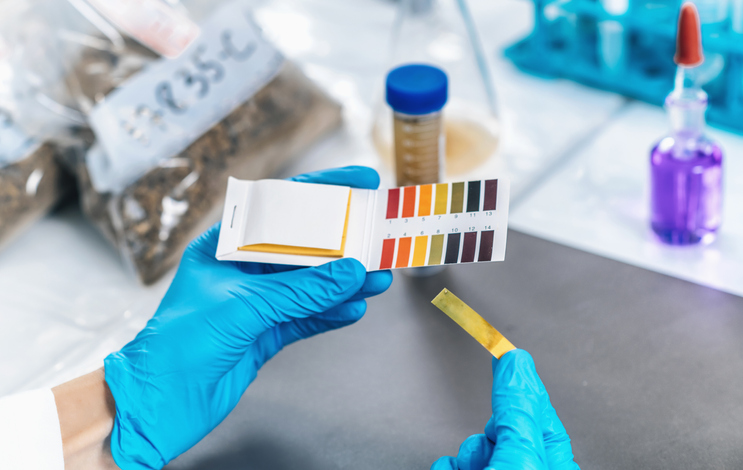Making Sensible Investments In Liming Materials

Audrey Gamble
Alabama Cooperative Extension System
Landowners today are flooded with marketing efforts from “liquid lime” companies which claim to increase soil pH and improve crop yields with product rates of one to five gallons per acre.
While it would be convenient to substitute a few gallons of a liquid product for a ton of ag lime, this Alabama Extension’s Audrey Gamble said this is a simple case of “if it sounds too good to be true, then it probably is.”
Why Is Maintaining Soil pH With Lime Important?
Maintaining soil pH is arguably the most important management practice for improving soil fertility for crop and forage production. Most Alabama soils are naturally low in pH and must be limed to create soil conditions, which increase plant nutrient availability and decrease aluminum toxicity.
The ideal pH for most Alabama crops is 6.0 to 6.5. When the pH falls below 6.0, the availability of some nutrients (such as nitrogen and phosphorous) begins to decrease. Maintaining pH according to soil testing lab recommendations will ensure the availability of all plant nutrients is maximized, so fertilizer applied to the soil does not go to waste.
How Are Accurate Lime Rate Recommendations Determined?
To raise the pH of an acidic soil, liming materials must be applied. The amount of liming material needed to reach a target soil pH depends on the soil’s current pH and the soil’s buffer pH. Soil pH measures the active acidity of a soil, while soil buffer pH estimates the soil’s reserve acidity (resistance to change in pH).
Soils high in organic matter and clay content have a higher reserve acidity and require more lime than sandy, low organic matter soil to raise pH the same amount. For example, a sandy soil at pH 5.0 may require only 1 ton of ground limestone to raise the pH to 6.5, while a clay soil at the same pH may require 4 tons of ground limestone. A one-unit increase in soil pH is equivalent to a ten-fold increase in soil acidity, so small changes in soil pH can result in different lime requirements.
Soil testing labs measure both soil pH and buffer pH to make accurate lime recommendations to producers. This is the best way to accurately test the amount of lime which needs to be applied to the soil.
How Do Liming Materials Increase pH?
Liming materials are alkaline and contain carbonates (CO32-), hydroxides (OH–), oxides, or silicates (SiO4)4- of calcium and magnesium. As liming materials dissolve in water, acidic soil cations of aluminum (Al3+) and hydrogen (H+) react with carbonates (CO32-), hydroxides (OH–), or silicates (SiO4)4- to form water and insoluble aluminum minerals, thereby reducing the acidity of the soil.
What Determines Effectiveness Of A Liming Material?
Not all liming materials are of equal quality, and the effectiveness is based on
- Calcium carbonate equivalent (a measurement of the material’s ability to change pH)
- The particle size of the material. Fineness of liming materials effects how quickly they will react with the soil.
The most common liming materials in Alabama are ground calcitic limestone and dolomitic limestone. Other common liming materials include byproducts such as wood ash.
Not all products containing calcium and magnesium are liming materials. There are some “alternative” liming products on the market today which have no ability to increase surface soil pH. Examples include chloride, calcium sulfate and magnesium sulfate. These products can have value as calcium or magnesium fertilizers at the appropriate recommended rates and can reduce aluminum toxicity in highly acidic subsoils, but they do not increase soil pH.
Contact a local Extension agent for help in determining whether a calcium or magnesium product is a liming material or fertilizer.
Other “liquid lime” products containing small amounts of calcium carbonate dissolved in water claim to adjust soil pH with 1-5 gallons of product per acre. Beware of these products. Since actual liquid lime material consists of approximately 50% lime and 50% water by weight, the amount of liquid lime required to increase the soil pH by the same amount as one ton of lime would be much higher than could be contained in 1 to 5 gallons of product.
How To Test Liming Material To Determine Effectiveness
Alabama has a state lime law which specifies a product cannot be marketed as an agricultural limestone unless:
- the material has at least a 90% calcium carbonate equivalent
- at least 90% of the material passes through a 10-mesh sieve
- at least 50% of the material passes through a 60-mesh sieve.
Products which meet these requirements have a relative neutralizing value (RNV) or effective calcium carbonate equivalent (ECCE) of at least 63%. Therefore, producers can be guaranteed that a product is at least 63% effective if they buy an ag lime product in Alabama.
For other liming products, such as wood ash, it is important to have a lime analysis done to test the effectiveness of the product. Most soil testing labs have the ability to test for lime quality.
How Can I Adjust My Lime Application Based on Its Relative Neutralizing Value?
Soil testing laboratories make varying assumptions regarding RNV when reporting lime recommendations. The Auburn University Soil Testing Laboratory assumes a liming material is 63% effective when making lime recommendations, since agricultural lime products in Alabama are required by law to be at least 63% effective. Other laboratories may assume that the liming material is 80% effective or 100% effective. Depending on the assumed RNV, recommendations by soil testing laboratories may result in over-application if a high-quality limestone is used or under-application if a very poor-quality ground limestone or by-product is used.
